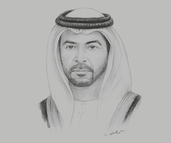Sheikh Hamdan bin Zayed Al Nahyan, Ruler’s Representative in the Al Dhafra Region : Interview

Interview : Sheikh Hamdan bin Zayed Al Nahyan
How can the province support the energy sector’s growth in an environmentally responsible manner?
SHEIKH HAMDAN BIN ZAYED AL NAHYAN Al Dhafra has the means and motivation to support energy’s growth in a fashion that preserves the environment for future generations. As part of UAE Energy Strategy 2050, Emirates Nuclear Energy Corporation is currently building, in accordance with the highest global standards of safety, quality, efficiency and sustainability, the nation’s first civil nuclear energy plant at Barakah; the first of the site’s four units was completed in March 2018. Once fully operational the plant will satisfy about 25% of the UAE’s electricity needs and save up to 21m tonnes of carbon emissions each year, which will contribute greatly to the UAE government’s efforts to meet its obligations under the Paris climate agreement.
The region is rapidly emerging as an important locus of energy production, as hydrocarbons, renewables, and nuclear power help to satisfy growing national and global demands for electricity, and foster the human resources necessary to leverage our existing fuel and industrial complexes. For instance, the Abu Dhabi National Oil Company’s expansion of the Ruwais refinery complex is expected to directly and indirectly generate thousands of new jobs by 2025, in addition to accounting for 1% national GDP growth.
How can Al Dhafra strengthen its connectivity with both the rest of the emirate and its neighbours?
SHEIKH HAMDAN: The Surface Transport Master Plan (STMP) sets out a strategy for improving both intra- and inter-regional synergies, in order to bring Al Dhafra together with the rest of Abu Dhabi, the other emirates, Saudi Arabia and Oman.
The key is the development of a major road and rail system along the coastal corridor that makes up the main trade route among the emirates and other Gulf states. Recognising this, in early 2018 the Department of Transportation completed a part of the STMP that envisioned transforming the E11 road into a freeway to provide a fast, safe and non-stop connection between Saudi Arabia, Abu Dhabi and the other emirates.
The STMP also maps out a railway network between our major cities, ports and industrial centres. Since June 2009 Etihad Rail has been tasked with managing the development, construction and operation of a national freight and passenger railway network; stage one has been operational in Al Dhafra since 2016. By bridging the emirates and linking us to our fellow GCC members, the system’s completion is expected to redefine logistics and transport in the region.
What can the region do to ensure it has the human capital needed to sustain its fast-growing sectors?
SHEIKH HAMDAN: Al Dhafra has made significant progress in developing a skilled workforce by improving the region’s education system. We have placed a strong focus on skill acquisition that will enable our graduates to meet the ever-changing demands of 21st-century labour markets. For instance, learning English has better equipped our students to thrive in various existing and emerging fields, such as ICT, petrochemicals, nuclear power, engineering and health care. The Abu Dhabi Vocational Education and Training Institute (ADVETI) analyses market needs and works with related entities, such as the emirate’s Human Resources Authority and the Ministry of Human Resources and Emiratisation, to furnish programmes that train Emiratis to satisfy those demands. Similarly, ADVETI also liaises with the Ruler’s Representative Court in Al Dhafra to help citizens further their educations or careers through training programmes that align with current industry trends. Furthermore, our youth continue to receive opportunities to travel and advance their learning by studying abroad in high specialised fields. Both internal and external scholarships are in place to defray the costs that nationals incur and help them qualify for high-demand sectors.
You have reached the limit of premium articles you can view for free.
Choose from the options below to purchase print or digital editions of our Reports. You can also purchase a website subscription giving you unlimited access to all of our Reports online for 12 months.
If you have already purchased this Report or have a website subscription, please login to continue.

